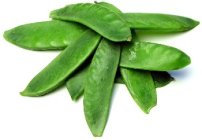Languages
Mangetout

The mangetout, also known as snow pea, differs from the shell or marrow pea mainly in the fact, that it does not create an inedible parchment layer at the interior wall of the pod; it also owns a considerably high sugar content. Hence, snow peas may be prepared and consumed with the whole fleshy, unripe, but tender and sweet pod including the still unripe seeds contained therein.
Mangetouts are cultivated only for the fresh food market. The "petit pois" (French for little peas) which are cultivated in France and have a small seed corn are also considered sweet peas. Young and freshly harvested, they taste very delicate. They are a popular addition to salad dishes, or they may be blanched, stirred in butter and seasoned with mint.
